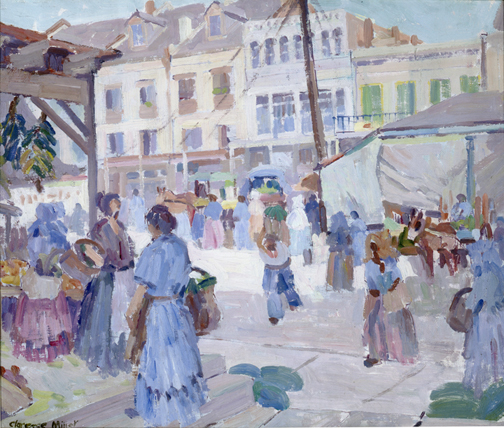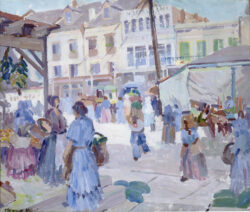Clarence Millet
Clarence Millet, one of most important and prolific painters working in twentieth-century New Orleans, was one of the few Southerners elected as an associate to the National Academy of Design in 1943.

Courtesy of The Historic New Orleans Collection
French Market. Millet, Clarence (Artist)
Clarence Millet, one of most important and prolific painters working in twentieth-century New Orleans, earned a national reputation; he was one of the few Southerners elected as an associate to the National Academy of Design in 1943. Millet was not an innovator but rather popularized a light-filled, breezy style of impressionism, which influenced his contemporaries and later twentieth-century Southern artists. Like his many of contemporaries, he painted the picturesque architecture of the old French Quarter and the freshness of the surrounding countryside with “a sense of motion and vigor.” He was fond of saying, “I paint things I know, see and feel. I try to impart to the beholder an experience I have seen and felt.”
Early Years and Schooling
Millet was born in 1897 to Theophile and Mathilde Madre Millet in rural Hahnville, Louisiana, twenty-one miles upriver from New Orleans. After public schooling, he came to New Orleans at age seventeen to work as an apprentice in an engraving company. This training would serve him well later in his career when he created popular prints of the French Quarter.
In 1917, Millet spent the winter months in New Orleans studying and painting with Chicagoans Robert W. Grafton and Louis Oscar Griffith, who shared studio space in the French Quarter. That year, Grafton and Griffith were commissioned to paint large murals of local subjects for the new opulent St. Charles Hotel. Having studied in Paris, they were shaped by French Impressionism, both in style and in their choice of “everyday” subject matter. Their influence on the young Millet was profound. The environment of the old colonial town at this time must have been a heady tonic to Millet. The grand buildings were dilapidated and rundown but offered cheap studio space. It was fast becoming a colorful, bohemian art colony, as a writer for The Item-Tribune stated in a banner headline on February 5, 1928: “New Orleans As Artist’s Mecca – Nearly All Reside in Quarter.”
Millet enrolled in in 1920 at Tulane University, where William Woodward was on the faculties of both the Fine Arts Department and the School of Architecture. Woodward, an extremely influential artist, art educator, and historic preservationist, was the first to systematically document buildings of the old French Quarter, using oil crayon in an Impressionist manner.
From 1922 to 1924, Millet attended the New York Art Students League, taking drawing lessons with academic master and anatomist George Bridgeman. This instruction may account for the simplified compositions of many of Millet’s earlier works, as well as the well-constructed forms that appear throughout his work. Although key artistic influences can be readily identified, it is curious that Millet declared himself “largely self-taught.”
Career Development
At the end of his New York schooling, Millet took up permanent residence in New Orleans at 1240 North Galvez Street in 1925 and set up his studio in the same shabby building as Alexander Drysdale, next to a Chinese laundry in Exchange Alley in the French Quarter. Millet later rented space at 628 Toulouse Street, in the old Governor Claiborne House, where artist Alberta Kinsey had her studio. His subjects, whether a rain-drenched overcast morning in Jackson Square or a windy day at the batture shanties along the Mississippi River, were painted with swift sure strokes, capturing the light and movement of nature.
Millet was active in local art organizations and clubs. He was a founding member of the Arts and Crafts Club of New Orleans in 1922 and taught outdoor sketching and painting. The club was the lifeblood of the old French Quarter art colony; members taught fine art and crafts, provided exhibition space, and introduced guest lecturers on national and international art trends. New Orleans’ newspapers always praised Millet’s art, which he showed regularly at the exhibition hall of the club: “Clarence Millet has several of his clean, moist healthy-looking Frenchtown and landscape studies.”
Millet was also a charter member of the New Orleans Art League, an offshoot of the Arts and Crafts Club established in 1925. This exclusively male club met in the Governor Claiborne House where Millet had his studio. Members organized the first outdoor art exhibition in the French Quarter, as well as traveling exhibitions, and provided studio space for young artists. The Arts and Crafts Club of New Orleans followed suit with an annual spring art show in the alleyways on both sides of St. Louis Cathedral. Millet was a devoted supporter of this show, which eventually was rechristened the Spring Fiesta Art Show in 1937. The art show is the subject of his well-known painting, now in The Historic New Orleans Collection. This painting is a historically important genre piece depicting the French Quarter artists hanging their work on the fence in Jackson Square, with gawking pedestrians and bustle of the city street in the background. The painting is enlivened with gestural attitude, bright splashes of color, and contrasting patches of light and shadow. It is not a moment lost in time but rather a tradition still alive today in the French Quarter, where artists customarily hang their work on the fence of the grand old square.
Beyond the French Quarter associations and clubs, Millet belonged to the New Orleans Art Association, the Southern States Art League, and the Mississippi Art Association. His work was exhibited widely, in solo and group shows at the Isaac Delgado Museum (now the New Orleans Museum of Art) and in at least thirty-five cities across America, including the National Academy in New York, the Pennsylvania Academy of Fine Arts in Philadelphia, the Art Institute of Chicago, and the 1939 New York World’s Fair. Millet was very much part of the art establishment and presented an “uneccentric” appearance, in contrast to some of the “besmocked, bearded characters and lowlifes” in the Quarter. His friends in the art circle were the etcher Morris Henry Hobbs, the painter Charles Reinike, and sculptor Albert Rieker.
Later Career
In the Depression years, the art community thrived under the Federal Art Project in Louisiana, which Millet joined by 1934. He painted Madame John’s Legacy and the Beauregard-Keyes House in the required factual format. He also applied his straightforward realist style to a new artistic endeavor. In 1939, he joined his friends Morris Henry Hobbs and Charles Reinike in organizing the Louisiana Society of Etchers. Even though printmaking tended to court the tourist trade, his numerous etchings, woodblocks, and prints, some of which were hand colored, did much to popularize and ultimately encourage the preservation of the historic buildings of the French Quarter.
After World War II, Millet’s painting seemed to become less impressionistic, more controlled and structured. The palette loses its fresh clarity and lucidity. Colors depart from nature’s rule, yet his compositions remain strong and his powers of observation acute. When Millet died in New Orleans in 1959, he left perhaps the greatest legacy of paintings, watercolors, and prints of all the French Quarter artists. His art has ensured that the impressionist style would outlast any artistic form of modernism in the South through the twentieth century. His work is found in The Historic New Orleans Collection, the Ogden Museum of Southern Art in New Orleans, the New Orleans Museum of Art, and the Louisiana State University Museum of Art in Baton Rouge.
